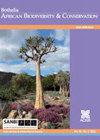马拉维马杰特野生动物保护区木本植物群落的结构和组成
IF 0.5
4区 生物学
Q4 PLANT SCIENCES
引用次数: 1
摘要
背景:在面对全球变化和人口增长的情况下,保护区作为马拉维本土植被的避难所的作用,特别是miombo林地,将变得越来越重要。因此,准确了解植物群落木本成分的范围和组成将在保护和管理举措方面发挥至关重要的作用。目的:本研究的目的是:(1)利用遥感和地面调查相结合的方法对马杰特野生动物保护区(MWR)的木本植物群落进行分类、描述和绘制;(2)编制MWR中存在的乔灌木物种清单。方法:采用遥感与实地调查相结合的方法,对水利区木本植物群落进行分类、描述和制图。此外,还对所圈定的木本植物群落的乔灌木物种进行了清查。结果:水利区共鉴定出5个不同的木本植物群落,其中2个群落分为3个亚群落,共鉴定出31科118种木本植物。介绍了各群落的位置、结构和物种组成。Miombo是分布最广的群落(占面积的35.9%),而低海拔灌丛和林地是植物区系最丰富的。结论:这些信息旨在为改进管理规划和政策制定提供基础,包括火灾管理、基础设施的安置和灭绝哺乳动物物种的重新引入,以及为监测变化提供基线。此外,这项研究提供了一个例子,说明遥感和地面调查相结合如何能够提供一种快速和相对便宜的方法,在相对精细的尺度上对大面积的群落的木质成分进行分类,这可能对经历快速和不断变化的发展中国家和地区特别重要。本文章由计算机程序翻译,如有差异,请以英文原文为准。
Structure and composition of the woody plant communities of Majete Wildlife Reserve, Malawi
Background: The role of protected areas as sanctuaries for indigenous vegetation in Malawi, particularly miombo woodlands, will become increasingly important in the face of global change and rising human populations. Accurate knowledge of the extent and composition of woody components of plant communities will therefore play a vital part in informing conservation and management initiatives.Objectives: The aims of this study were to (1) classify, describe and map thewoody plant communities of the Majete Wildlife Reserve (MWR) using a combination of remote sensing and on-the-ground surveys, and (2) to compile an inventory of the tree and shrub species present in MWR.Methods: A combination of remote sensing and on-the-ground surveys was used to classify, describe and map the woody plant communities of MWR. Additionally, an inventory of the tree and shrub species in each delineated woody plant community was made.Results: Five distinct woody plant communities, two of which were subdivided into three sub-communities each, were recognised in MWR, and a total of 118 woody plant species within 31 families were identified. A description of the location, structure and species composition of each community is provided. Miombo was the most widespread community (covering 35.9% of the area), while the lower-altitude shrublands and woodlands were the richest floristically.Conclusion: This information is intended to provide a basis for improved management planning and policy development, including fire management, the placement of infrastructure, and the re-introduction of extirpated mammal species, as well as providing a baseline against which to monitor change. Additionally, this study provided an example of how the combination of remote sensing and ground surveys can provide a rapid and relatively inexpensive method for classifying the woody components of communities at a relatively fine scale over large areas, which may become particularly relevant for developing countries and regions that undergo rapid and constant change.
求助全文
通过发布文献求助,成功后即可免费获取论文全文。
去求助
来源期刊

Bothalia
生物-植物科学
CiteScore
1.70
自引率
0.00%
发文量
12
期刊介绍:
Bothalia: African Biodiversity & Conservation is published by AOSIS for the South African National Biodiversity Institute (SANBI) and aims to disseminate knowledge, information and innovative approaches that promote and enhance the wise use and management of biodiversity in order to sustain the systems and species that support and benefit the people of Africa.
The journal was previously published as Bothalia, and had served the South African botanical community since 1921. However the expanded mandate of SANBI necessitated a broader scope for the journal, and in 2014, the subtitle, African Biodiversity & Conservation was added to reflect this change.
 求助内容:
求助内容: 应助结果提醒方式:
应助结果提醒方式:


